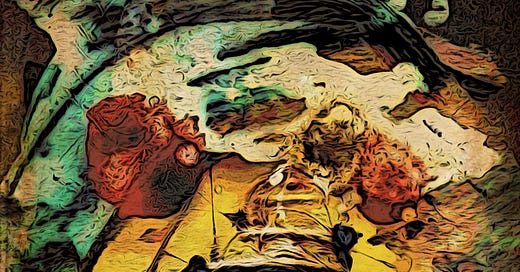You Cannot Practice What You Cannot Distinguish
People Say Practice Makes Perfect. What Separates a Master from a Dabbler?
When I was a child, the mystery of life appealed to me greatly. It wasn’t the secret that I was curious about. It was rather the “showing up” or phenomenon of life itself that I was fascinated by.
Many nights before sleeping in the dark, I was led into a peaceful meditative state. It felt like I was in a warm cocoon, almost hypnotized by the energized hum of the universe. Inside this unfathomably giant information feed, I was communing with silence.
Back to Earth
For many years, I have trained and coached people to better understand themselves in relationship to what they do. Merging self-inquiry and keen insights into performance, leadership, and both personal and professional development, I encourage individuals to reaffirm the original foundation of their motivation, decisions, and behavior.
Because of my background in the performing arts since the 80s and a long dive into behavioral psychology (Behavioral, Cognitive, and Humanistic) as it relates to professional development, I was inspired to work with countless individuals outside of show business. People from all walks of life such as leaders, entrepreneurs, journalists, consultants, therapists, bankers, trial-attorneys, as well as athletes, celebrities, universities, marketing strategists, CEOs, executives, etc.
Behind the Curtain
Beneath the surface of every polished performance lies the crucial skill of distinguishing. For instance, in sports or dance, athletes and performers must distinguish between precise movements and body positions to give meaning to what they do. This allows them to execute intricate routines, maintain balance, and perform with grace.
In the art of fine cuisine, a chef relies on their ability to distinguish between various flavors and textures in ingredients. This skill enables them to create well-balanced and delicious dishes by combining ingredients that complement each other while avoiding clashes in taste and texture.
People Say Practice Makes Perfect
In truth, you cannot practice what you cannot distinguish because the foundation of practice rests on recognizing and refining distinctions, not blind repetition of things you do not thoroughly understand. I have a saying:
“When we don’t understand something, we resort to one of three modes of behavior: we blame, deplore, or quit—all in a spirit of frustration”.
To distinguish is to differentiate, to discriminate, and to identify. The ability to make distinctions grants greater control over your skills and talents. Technique, too, hinges on the power of distinction. For instance, if you are a public speaker, neglecting to distinguish gestures or postures as highly specific tools for audience impact can significantly diminish your effectiveness. Another striking example is Eskimos and snow. They separate snow for drinking water, snow to build igloos with, and still snow you can walk on. There’s also snow you will fall through and possibly die. Imagine not knowing these distinctions!
Two Separate Worlds
In the realm of daily living and working, there exist two fundamental dimensions that demand our attention: the world of thoughts or concepts and the experiential world, the realm of physical sensations. These dimensions are distinctly separate.
The world of thought is a realm of measurements, comparisons, computations, and conceptualizations. They are all mental projections of images or concepts and do not have to be experienced.
In contrast, the world of sensations exists as a realm of energetic vibrations where everything is sensed and felt physically. Vision, hearing, touch, smell, sound, and more, all come alive and distinguish themselves through the dynamic interplay of energy in the physical world. Therefore, a mental experience is not a real experience in terms of its nature. Think of reading a menu at a restaurant. As you can imagine the dishes conceptually, you will need to eat them physically to have a culinary experience.
As an example, in the context of speaking and communicating, the art of distinction is paramount. What we can distinguish empowers us with greater freedom of expression and confidence. Imagine a world where we couldn't distinguish right from left; it would turn life into an ordeal. The mind's capacity to compute relies on our ability to distinguish. A square is not a triangle, and these distinctions matter.
The dimensions of the body and physical sensations serve as a solid foundation, offering confidence and stability. In contrast, the thought dimension can be treacherous due to its inherently conceptual nature. A prime example is that words must be heard through sound before they can be understood as concepts. Similarly, one cannot will anything into existence without engaging the body and the senses. When you reach for that glass of water on a podium, it is an act rooted in the physical, not merely a conceptual notion.
This notion underscores the importance of paying closer attention to how much our daily actions are influenced by the rules of the physical world. The mental realm is where anxiety, stress, and tension originate. Conversely, the physical realm serves as an effective shock absorber. Only the physical world truly grounds us, such as gravity or our breathing.
You can instruct your mind to relax for an eternity, but it will remain ineffective until your body reconnects you to the world of sensations. To let go and relax is a physical act first. What you can touch, smell, see, feel, and hear constitutes reality. They are the conduits to experience and accomplishment. Anything beyond that remains abstract representations. At the incredible speed we live at, it is increasingly easy to confuse the two.
In conclusion, mastering the art of distinguishing between the mental and physical dimensions is the key to effective living and a gateway to mastering it.
Embracing the physical realm as the anchor for our aspirations and intentions will not only enhance confidence but elevate the impact of your words and actions. In a world where distinctions matter absolutely, it is the ability to bridge these two dimensions that sets you apart and leads to mastery.
ABOUT THE AUTHOR
Husband | Performance & Leadership Coach | Visual Artist & Author |
These articles aim to help the reader gain insights into personal growth and development. My work as a mentor is to catalyze awareness and empower creative thinking.
My writings are essays in intuitive awareness, offered as musings to enhance personal effectiveness, fulfillment, and greater clarity of purpose. Science uses intuition to establish new paths of inquiry to advance possible theories. I favor a metaphysical exploration through my intuition rather than fit-all reasoning.
Every decision in business or life is a new direction. Hence, it is our choices and their inherent consequences that determine the quality of our experiences. It is clear to me that the ultimate navigational system is our instincts, intuition, and emotional intelligence.
These writings are geared to empower with actionable insights and valuable techniques to navigate life’s challenges with renewed confidence. It can transform and accelerate your growth and skill set where it matters.
Speakers & Artists International Public Speaking & Media Training
Quantum Design Connection Leadership & Business Coaching
Hollywood Actors Studio Performance Skills
Aquadigigraphy A New Look at Art
Book Author
Copyright © 2024 Eric Stone Quantum Design Connection







Thank you! That was great and so timely for me. Amazing!